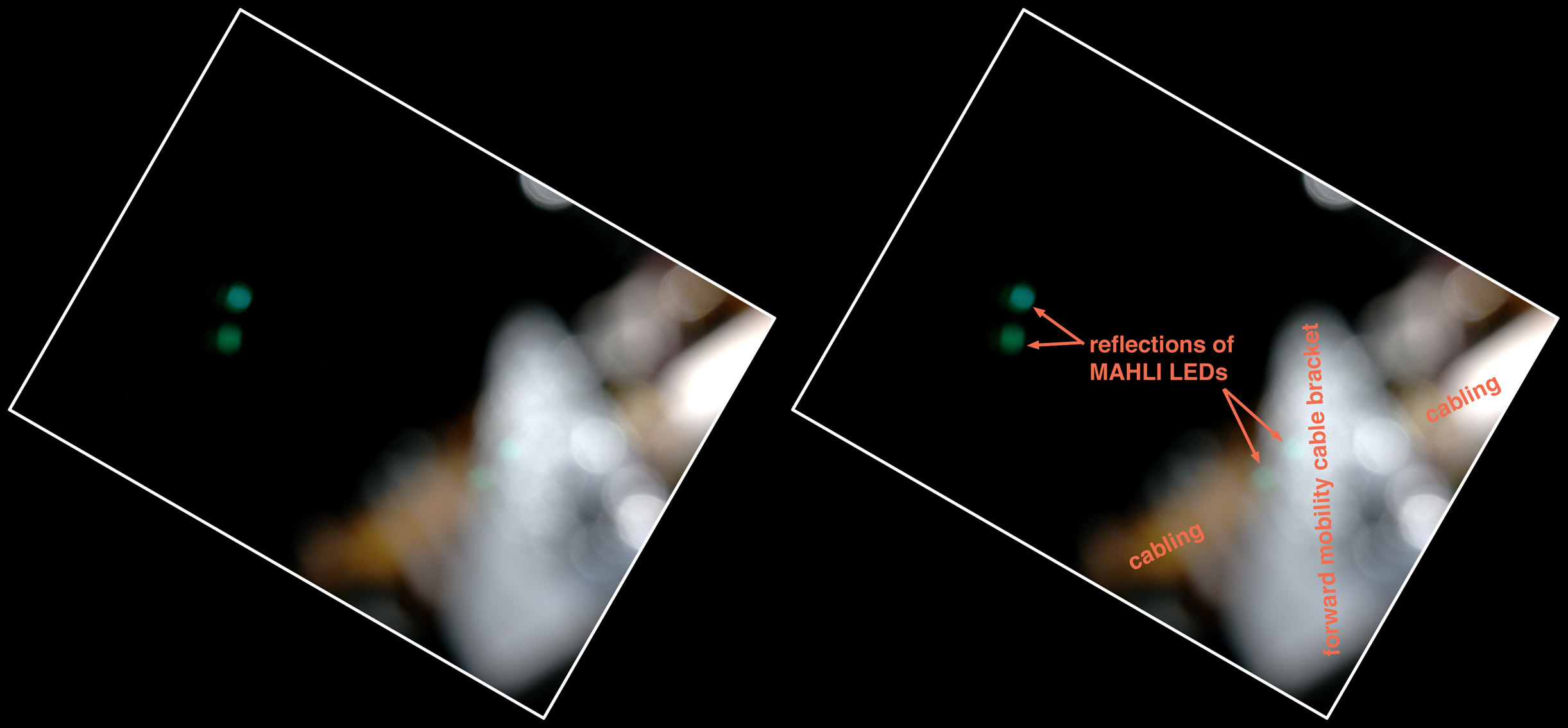What's it like inside the spacecraft that is carrying NASA's Curiosity rover to Mars right now? Using its own white light LEDs (light emitting diode) source, the Mars Hand Lens Imager (MAHLI) aboard the Mars Science Laboratory rover acquired this full-color test image inside the dark cruise vehicle and aeroshell on 20 April 2012. It is a test image used to check that the camera is performing as expected following its 26 November 2011 launch.

NASA/JPL-Caltech/Malin Space Science Systems
The second figure shows the MAHLI test image with and without explanatory annotations; in this case, the image has been rotated so that up and down are relative to the positions of the rover deck (up) and the rover's wheels (down). The first thing one notices is that the scene is out of focus. This is as expected. The MAHLI is designed to take close-up images of rocks and regolith ("soil") on Mars; it can also take pictures of the Martian landscape. To acquire these images, the MAHLI lens has the ability to change focus. To focus the MAHLI requires commanding a motor to move the focusable part of the MAHLI lens. When the camera is not in use, the motor positions the lens mechanism in a way that protects the system from the vigorous vibrations that occur during launch, descent and landing, and during operation of the rover and its tools on Mars. The focus mechanism is not operated during the cruise to Mars as a precaution to ensure that the system remains in a safe configuration for the landing in the martian crater, Gale, on August 5, 2012, Pacific Daylight Time.

NASA photo KSC-2011-7089; NASA/Kim Shiflett; cropping/annotation by Malin Space Science Systems
When the lens mechanism is in this safe, launch restraint position, the camera's transparent dust cover is closed and the lens is in focus only for targets that are about 2.1 centimeters (0.8 inches) from MAHLI. During the cruise to Mars, there are no targets this close to the camera. What is in the field of view, then, is out of focus. The nearest feature, a bracket that holds some cables that are part of the rover's mobility (driving/wheels) subsystem, is about 19 centimeters (7.5 inches) away. A photograph taken on 23 September 2011 at NASA's Kennedy Space Center, Florida, before launch illustrates what is in the MAHLI field of view at the time the April 2012 image was obtained. The grayish feature is the top of the forward mobility system cable bracket, the orange or copper-colored features are some of the cables that are restrained by the bracket. The bracket and cables are mounted on a black bar which is the forward rocker of the rover's six-wheeled mobility system. These features are only in the MAHLI field of view during the launch, cruise, and descent to Mars; when the rover touches down in Gale, these will have unfolded beneath the rover to support its touchdown and Mars roving capabilities.
|
To cite the image(s) and caption information in a paper or report:
Edgett, K. S., M. A. Ravine, R. A. Yingst, M. A. Caplinger, J. N. Maki, and the MAHLI Engineering, Science, and Operations Team (2012), Curiosity's Hand Lens Imager (MAHLI) acquires test image enroute to Mars, Malin Space Science Systems Captioned Image Release, MSSS-223, http://www.msss.com/science-images/mahli-acquires-test-image-en-route-to-mars.php.
The image(s) and caption are value-added products. MSSS personnel processed the images and wrote the caption information. While the images are in the Public Domain, NASA/JPL-Caltech/MSSS requests that you credit the source of the image(s). Please give the proper credit for use of the image(s) and/or caption.
|
Malin Space Science Systems (MSSS) built and operates the Mars Hand Lens Imager (MAHLI) aboard the Curiosity Mars rover. MSSS also built and operates the rover's Mastcams and Mars Descent Imager; this work is performed under contract to NASA through the Jet Propulsion Laboratory, a division of the California Institute of Technology. MSSS is also currently operating two cameras onboard NASA's Mars Reconnaissance Orbiter (MRO), the Mars Color Imager (MARCI) and the Context Camera (CTX) and is monitoring the health of Junocam, a MSSS-built camera on its way to Jupiter aboard NASA's Juno spacecraft. Other activities of the company are described at www.msss.com.
|
|






